On we go into a new century with Des Prez without doubt the most highly thought of composer of the time. Des Prez was an almost exact contemporary of Leonardo Da Vinci, born a couple of years earlier and dying a couple of years later than the artist (1521). It is believed Leonardo also painted Des Prez’s portrait during Des Prez’s few years spent in Rome in the early 1490s. They were held in much higher esteem than their predecessors and as a result of their contributions, the status of the artist and composer would improve very much. I have referred to Des Prez’ predecessors as composers when really at the time they were seen first and foremost as choirmasters. In this century the best composers were more than this, and the best artists (thanks to Leonardo) were more than just people who were good with their hands, they were regarded as men of genius.
Another shift around the time of Des Prez’s final years, that is the first couple of decades of the 1500s, is the rise of instrumental music. Before the 1500s we know very little about instrumental music because it was not written down. From this we can conclude that with purely instrumental music, the musicians would improvise a lot and play from memory in the same way pop and rock bands do today. Early wind and keyboard instruments and other types might too have been used to play the lower parts in some of the motets and masses by Dufay, Ockeghem and Des Prez and their contemporaries because those parts occasionally do not tie in with the text they are given in the way the upper parts do.
As instrumental music begins to emerge in the early 1500s, the most popular instrument was the Lute. The second most popular for some reason was apparently the Viol. The Lute had been around in various forms for centuries. It sounded not unlike a Moorish instrument called the Oud and for that reason, in recently unified Spain where they were trying to break away from Moorish culture they preferred the sound of the newly developed lute like plucked instrument called the Vihuela. The Vihuela would later evolve into the guitar towards the end of the 1500s but in the latter half of the 1400s some people began playing Vihuela with bows, like a violin and this led to the development of the Viol.
Are you still with me......Good.
So the Viol was played with a bow but it had frets on the neck like a guitar. I never like criticising music in a negative way especially not in writing because shortly after I do I often hear Bob Dylan singing ‘don’t criticise what you can’t understand!’. I was probably a bit harsh on the troubadours back in my 1200-1300 post. Well I am going to take the plunge again here and declare that I cannot put up with the sound of the Viol. It is not just that it is sonically unsatisfactory, there is something in its scraping like sound that catches a nerve in my teeth and I have to switch off. I had that problem when I used to play the violin as a child. That is not to confuse the Viol with the Violin which had different origins from the east and also began to emerge in Northern Italy in the early 1500s. Violin music would yet have its day. The Lute on the other hand is the best sounding instrument they had and became more and more popular as the century progressed and although this instrument is obviously very old fashioned now, it still sounds very good.
The emergence of instrumental music was largely helped by the printing press which had been invented around 1455. It is thanks to the printing press that a set way of playing a particular piece could now be committed to paper and reproduced en masse. This helped instrumental music to become better established so it became less about improvisation and more about creating proper musical works. The printing press had so far been used mainly for literature and art. Some church music had been printed since about the 1460s but in 1501 the first book of secular music was published
by the entrepreneur Ottaviano Petrucci. Realising its potential Petrucci had got himself an exclusive 20 year licence for music printing in Venice and in doing so invented modern music publishing and revolutionised the distribution of music. This first collection entitled '
Harmonice Musices Odhecaton' included works mostly by Des Prez and another famous composer of the time called Heinrich Isaac. It contained vocal and instrumental music though the version on Spotify seems to consist mostly of pieces played by the Viol, so I’m steering clear. Among Petrucci’s many publications though is a very pleasing example of early lute music from his ‘Intabalatura de Lauto 4’ collection of 1508 called '
Calata Ala Spagnola' by
Joan Ambrioso Dalza. It is interesting to hear how the format first heard with Leonin back in the late 1100s, that is a bass note that does not move too much is plucked below the upper line which carries the tune, like Leonin’s chant but a lot busier.
I have talked a lot about Des Prez but he really was the outstanding composer right up to his death in 1521 and in fact his influence and fame would continue right up to the end of this century. Following on from Des Prez came another Franco-Flemish (well more Flemish actually) composer named Adrian Willaert(1490-1562).
Des Pres had done much to establish the major triad chord first heard in Dunstable. If you listen to the final chord of the pieces by Dunstable, Dufay and Ockeghem, discounting octaves there are still just two notes, so although they liked the three part harmony the tradition of open fourths and fifths (that is chords without the note in the middle) was still quite well embedded in the music. With Des Pres the music really starts to become dominated by three part harmony as heard in Stabat Mater which ends on the triad chord, as if to say ‘we’re really alright with this harmony now’. Willaert too did much to establish this as the favoured mode of harmony and you can hear this in his
‘Ave Maria’ which too resolves on the major triad chord.
Like Des Pres, Willaert also made his way down to Italy, though in his case not to Milan or Rome but to Venice where he was to take charge of music for the city at St Marks. From here his fame and influence spread. In particular he did much to develop a new style known as ‘antiphony’ which came about because St Marks had galleries on opposite sides for the choristers and musicians. Antiphony is a call and response style of chant.
Magnificat Sexti Toni is a really good piece in this style.
I have not just picked these two works by Willaert to illustrate my points, they are my favourite ‘church’ pieces I have found by him. The Ave Maria may not quite make the standard reached by Dufay, Ockeghem and Des Prez but the ‘magnificat’ does a great job.
Clearly there was a lot of church music about and this had always been dominant but people like Petrucci and others in the bourgoisie class now wanted to hear and were in a position to see, that more secular music was made in a lighter, simpler, more fun style. We had seen the beginnings of this with Des Prez’ frottole in the 1490s and the purely instrumental music (mostly music for lutes and viols) coming in more at the start of the century. It is perhaps not surprising that it was in Paris, at this time the most heavily populated city in Europe, that a new wave of chanson composers would give this new direction for music real momentum as we get towards the 1520s.
Taking aside Des Prez’s ‘El Grillo’ and the spread of instrumental music for a moment there has been a broad consistency of style in the works I have selected from Dufay through Ockeghem to Des Prez and then Willaert. If you have heard those pieces, now listen to a contemporary of Willaert who was perhaps not as influential but equally famous and based in Paris.
The name of this, the most popular of the chanson composers whose music I want you to hear is
Clément Janequin (1485-1558). His best piece is probably
‘Les Chantes des L’Oiseaux’ from 1537. This amazing work starts not unlike a motet or mass from Des Prez but becomes progressively more extraordinary as the singers mimic the sound of birds in what must be one of the best and earliest pieces of program music ever composed (program music is music that basically meets its description given in the title or program notes). It took me by such surprise when I first heard it I was not quite sure what to make of it but after a few listens I really enjoy it and you have to say this is the work of a complete genius. Many of Janequin’s chansons imitate sounds from life in this way and he was enormously popular from the 1530s through to the 1550s (as was Willaert).
These French 'chanson' composers eventually found their way to Italy leading in the 1530s to the emergence of the Italian equivalent known as the 'madrigal'. All the leading composers in Italy at this time were of the Franco Flemish variety and Willaert was key in spreading the influence of the new form. I think I prefer his Magnificat to his madrigals but by way of example I can recommend a few good selections of his secular music. My favourite probably is ‘
O Bene Mio Fam'uno Favore’ (though it has to be the version on the ‘Venice Music’ album). You can hear the up beat style of the new music too in his
‘Vecchi Letrose’. This is not a million miles away from something that you might here on an album by Cat Stevens of whom I am a big fan, so this makes sense to me. Another nice one is
‘
A Quanda a Quandahaveva Una Vicina’ which I quite like (although I have to grit my teeth a bit through the Viols).
From the 1530s the Italian Madrigal grew in popularity and spread across Europe. This new music was largely stimulated by the rise in music printing with printing presses started in Paris in 1528, Lyons 1532, Wittenberg 1538, Nuremberg 1542, Antwerp 1543 and Louvain 1545. Although we have instrumentation and this was now song and dance music, these madrigals were largely composed in the old style of polyphony. By this I mean that the notes the instruments played were simply replacing the notes previously sung in the older motet form. Still the madrigal would become increasing popular and was the form by which composers would start to explore new musical territory. Increasingly the old church style of chant would become more redundant.
Before we get too radical with all this talk of madrigals, at last an Italian in Italy (up until now it has all been Franco-Flemish composers but it is going to be mostly Italian for about the next 170 years I think),
Giovanni Pierluigi da Palestrina 1525-1594 would have something to say about the old church chant, by composing apparently in one night sometime between 1555 and 1567 the finest piece of music created by anybody in Western Civilisation to date, surpassing all the previous achievements of every composer up to this point with what is said by many to be the greatest single piece of the entire renaissance era. In my book any way it is easily the best I have heard so far. This piece of music is Missa Pippa Marcelli and more specifically for me the
kyrie. The myth goes that the church had wanted to abolish polyphony and go back to plain chant as a result of the criticism they had received during the period reformation but that on hearing Palestrina’s mass, the decision makers convening at the Council of Trent were so moved that they were convinced otherwise. That has been proved untrue but the existence of this myth for so long demonstrates the love that is felt for this music. If you have quite liked the church music I have mentioned but perhaps have not gone overboard for it, you will love this piece I am certain.
It is the case that in terms of prestige the composers of the Willaert and Janequin generation remained in the shadow of Des Prez. Palestrina composing in Rome for the pope well and truly leaps out of this shadow, composing from the 1550s through to the 1580s. Palestrina’s slightly younger contemporary
Orland De Lassus (1532-1594) working in the same period was probably just as famous. He is the last in that line of great Franco Flemish composers going back to Dufay. I really did not think I would find anything from him on a par with Palestrina’s piece until I heard his Kyrie from the Missa bell Amfitrit Altera and that pretty much explains to me why he seems to be as well thought of as Palestrina. A very good madrigal too by Lassus is
Matona Mia Cara. Also worth a mention is his
"Ben convenne, madonna... Solo n'andrò".
There are two other composers coming in at the end of the Palestrina-Lassus period who are mentioned with high acclaim in all the books and websites and they are Tomas Luis de Victoria (1548-1611) and William Byrd (1543-1623) both composing mainly from the 1570s to 1590s and respectively consistently said to be the greatest Spanish and English composers of the century. I have been listening a lot to the kyries mentioned of Palestrina and Lassus and for me at the moment they seem to eclipse the choral church music of these other two composers and so I am afraid I have passed them by though if I do come across something as good I will come back and edit this paragraph. Unlike Tomas Luis de Victoria who composed mainly masses and motets, William Byrd though had other strings to his bow. He has composed some very good instrumental music and has succeeded in converting me to the sound of the harpsichord so I will come to him later.
For me the two kyries by Palestrina and Lassus are the culmination of the church chant that had emerged out of the dark ages with plain chant and I dare say they are the pinnacle of this musical form because nobody would ever surpass this, how could they. For that reason it is generally held, and the books on the subject will tell you, that this type of unaccompanied music had gone as far as it could go.
It may have been written a few years earlier, but we can take 1567, the year it was published that purely choral church music would reach its greatest peek with Palestrina’s mass. By this time, with the secular madrigal writing, they were really getting the hang of having the expression of the music match the words, which were mostly concerned with the aches and pains of love. In the 1570s and 1580s composers, artists and poets would get together to talk about what they thought the ancient Greek music would have sounded like, as one did in the renaissance times. The idea that musicians should play and singers should sing with real expression like actors playing out their parts in the ancient Greek plays began to take hold more and more. It was in 1589, for a wedding of the Medici family who ruled Venice, that several top composers of the day were asked to contribute musical interludes to a play that was written to be performed for the wedding. Although not conceived as such, this was the beginning of opera for the idea of fully uniting drama and music in a new format was born. This mixing of drama and instrumental music and madrigals became popular during the 1590s until ‘Daphne’ was composed by Jacobi Peri. This was the first ‘play’ consisting entirely of music, making it the first opera, and it was first performed in Florence in 1597.
Probably more so than in any other period in music before or since, was change in the air. For it was not only the start of opera at the end of this century. Change also came with
Giovanni Gabrieli (1557-1612), a pupil of Lassus and like Willaert another who composed in St Marks in Venice in the 1580s and 1590s. Gabrieli wrote church music like Lassus but specifically included parts for instruments. If instruments had been used for church music before they would really be playing out a vocal line. With Gabrieli it is clear that his intention was for these parts to be played by instruments and not sung. He also composed many instrumental only works. All the leading composers up to this point were mainly choral composers who dabbled with instrumentals. With Gabrieli we have for the first time a composer much of whose output was purely instrumental rather than choral.
Have a listen to ‘Canzon Duodecimi Toni a 10, C. 179’ in which all the instruments are brass.
William Byrd who I mentioned above, revered for his choral music also composed instrumental music. My favourite music I have heard by him are the harpsichord pieces from his collection entitled
‘My Lady Nevill’s Booke’ published in 1591. Unless I heard it in a song by say the Kinks, the Rolling Stones or the Stranglers I could never really stomach harpsichord music. I thought the piano was a technical advance on the harpsichord, like the violin is much better sounding than the viol so why bother listening to these old instruments at all unless put in some modern context. Well there is real charm in these keyboard pieces by William Byrd and they just would not be the same played on the piano as the way they sound on a harpsichord.
So the transition towards the end of this century from choral church music to opera and instruments is a monumental shift. In fact if ever there can be said to be a musical revolution this swing in emphasis must be it. This brings us to the end of the renaissance period and the beginning in about 1600 of a brand new era, which has come to be labelled the baroque period.
The selections from the 1500s for my Greatest Hitstory are:-
‘Ave Maria’ Adrian Willaert - Missa Christus Reseurgens/Magnificat/Ave Maria - Spotify 'Missa Papae Marcelli: kyrie' Giovanni Pierluigi da Palestrina - Palestrina Missae Papae Marcelli - Spotify
'Kyrie' Orlande De Lassus - Early Music - Spotify
And what about everything else:-
War in Europe seems to take up much of the century. Firstly France and Spain invade Italy and were in conflict with each other to gain control of Italy during much of the first half of the century. Henry VIII in 1544 joined up with the Holy Roman Emperor Charles V who also ruled Spain to invade France. In 1557 three new nations, Sweden, Denmark and Russia all fought for control of the Baltic. The Dutch protestants broke away from the rule of the catholic Spanish Hapsburg rule in a revolt started by William of Orange in 1562 until a truce was finally signed in 1609. Under Elizabeth I England and Spain are at war from 1587 until 1603.
This was the century of reformation of the church and that is largely why there was so much conflict in Europe at this time. There were many protestant groups that split from the catholics. Rulers from Scandinavia, England, Scotland and German states all broke away from the Roman Catholic church. There is civil war between catholics and protestants in Switzerland in 1530 and religious conflict in German states in the 1540s. In France there was civil war between the protestant Huegenots and the catholics between 1562-1598.
Aside from the wars in Europe the Spanish expanded west to Central and Southern America creating a vast empire. The Portuguese took Brazil but also went east to India establishing trade routes via the Atlantic and Indian oceans. Magellan, a Portuguese working for Spain was the first to circumnavigate the globe from 1519-1522, an extraordinary and significant achievement for mankind, and sea lanes were established across all the oceans creating a global trading network. The English, Dutch and French followed suit and went across the Atlantic to set up colonies in Northern America.
In Art
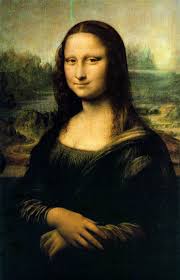
(most of this is summarising Gombrich's 'The Story of Art') Leonardo Da Vinci painted his Mona Lisa in 1502. In this painting he invented the ‘sfumato’ technique whereby he did not define the outlines so clearly, leaving a bit to the viewer's imagination which had the effect of the portrait appearing much more human and less stiff looking. He soon had to compete with a new kid on the block though, Michelangelo Buonarroti (1475-1564). Michelangelo could make incredibly alive portrayals of any posture or movement of the human body with ease. In 1504 the two rivals went head to head painting war paintings at the same time for the council chamber in Florence, though neither finished their work. Leonardo moved to France and Michelangelo went on to paint between 1508 and 1512 his giant fresco on the ceiling of the Sistine Chapel, the grandest and some say greatest work of art ever, this from an artist who considered himself more a sculptor than a painter and all done looking upwards everyday for four years on 60 foot high scaffolding.
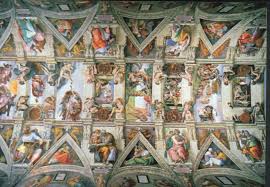
There was one other artistic genius, younger than Michelangelo, who came on the scene in Florence at this time and his name was Raphael Santi (1483-1520). He became a great rival to Michelangelo. Michelangelo had mastered the form of the human body while Raphael is said to have mastered the free movement and perfect composition of figures as can be seen in his most famous work the School of Athens painted from 1511-12. Leonardo, Michelangelo and Raphael are considered the greatest of the renaissance artists.

The focus of the art so far had been on mastering drawing and perspective. In Venice a new group was also emerging who treated colour with more importance than anybody, including the three Florentine masters had done before. The first of these was Giovanni Bellini 1431-1516. Bellini brought the oil painting begun by Van Eyck to Italy and you can see an example of his good use of colour, as well as light and shade, on the garments of the figures in his Madonna with saints 1508.
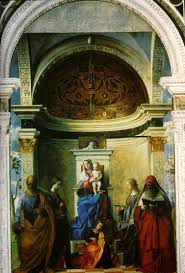
Bellini’s Pupil Giorgione would be the first one to have the landscape as a central component of his painting as can be seen in his Tempest.
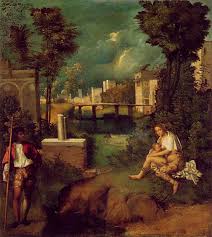
Another pupil of Bellini and best of all the Venetian painters was Tiziano Vecellio more commonly known just as Titian (1485-1567) who was nearly as famous in his time as Michelangelo. It shows how far the status of the artist had come by now when Titian dropped his brush and the Emperor Charles V picked it up for him. Titian’s masterpiece from his earlier period (he continued painting until the age of 91) is his assumption (below) in which the grand scale and use of light would have dazzled those who first came to view it.
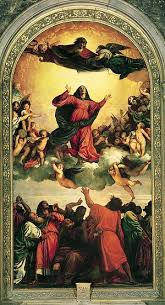
Titian then went on to paint mostly portraits as good as Leonardo’s Mona Lisa in terms of the way he made his figures look alive and this put him in huge demand. An example of this can be seen in his portrait of a man from about 1540.

Elsewhere Antonio Allegri from Parma, known more commonly as Correggio (1489-1534) used perspective in a brand new way, that is from down to up, when painting the ceilings of churches, by making them seem like they were opening up to the heavens. His most famous is probably the fresco on the ceiling of Parma Cathedral painted in about 1524. Many artists of future generations would use this idea.
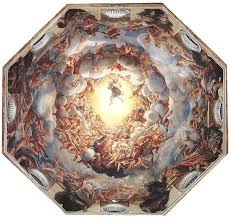
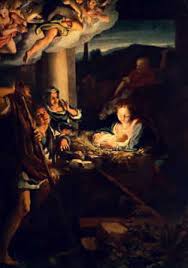
Another famous work by Correggio is his Holy Night painted between 1529-1530. Correggio followed Titian in showing what he could do with the effect of light. Titian had experimented in the composition of his paintings by not putting figures such as the Madonna in the centre and making that seem acceptable. Conventionally this painting too would not follow the existing rules of balancing the composition because there is not too much at all happening on the right but because your eye is drawn in naturally to the left by the light, Correggio manages to make it work as a whole.
In the north the greatest artist of the renaissance period was Albrecht Durer (1471-1528) His first real fame came in 1498 with the 15 wood gravings of the horrific doomsday scenes from the book of revelation and this caught the mood of the times with the growing insecurity of the church. Durer was also a genius of observation in painting and you can see this in his ‘young hare’ from 1502. He later took the mathematical lessons of perspective and proportion from the Italians, and from Bellini in particular and applied them to his wood gravings and prints making that a newly respected art form.
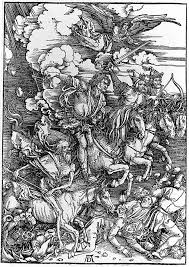
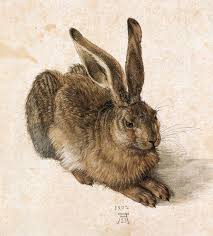
It is around the time of Durer that artists in the northern mainland Europe started to get interested in the landscape. You can see this in work by Cranach, an artist who loved the mountain scenery in his painting ‘the rest on the flight to Egypt’ in which the backdrop competes very strongly for attention with the figures themselves. Another German Albrect Altdorfer went the whole way and left the figures out completely in his landscape from 1532.
The top artist in the Netherlands of Durer’s generation completely ignored the developments in Italy. That is of representing as accurately as possible the proportions of the human body and correctly applied perspective. His name was Heironymous Bosch (c1450-1515). It is strange to think that he was a contemporary of Leonardo Da Vinci when scenes such as his ‘garden of earthly delights’ (below)seems closer to the surrealists of the early twentieth century than the renaissance masters.

The paintings in the north are really very different from that in the south so how were the new generation in Italy going to follow people like Leonardo, Michelangelo, Raphael and Titian? With these artists we reach a zenith by about 1520 as Palestrina would do in music a little later in the century, so the answer is with great difficulty. There was no way to ‘improve’ what they were doing in the way that those artists had made improvements on the work of their predecessors. Art could not stand still for fear of becoming boring and this was a real challenge which faced the next generation who, for the most part, were overshadowed by the great renaissance masters.
So a new period known as Mannerism lasted from about 1520-1600 in which the artists tried on the whole without too much success to develop the art of painting in new ways. This period was characterised by paintings that did not show the same concern for perfect balance. The Mannerist paintings are more restless than harmonious. Often the focal point is not the centre and sometime there is not one particular focal point at all. Many of the Mannerists did not care about having their figures in proportion. An example of this can be seen with Parmagianino who painted the freakish ‘Madonna with the Long Neck’. In short and in general, for the most part this period in painting is not too wonderful really.
Perhaps the most successful artistically of the Mannerists were Tintoretto (1518-1594). Tintoretto was one artist who wanted ‘to unite the drawing of Michelangelo with the colour of Titian’ and he confronted the problem of keeping art refreshing very well by choosing more elaborate and exciting subject matter for his works. In his paintings there is much more of a story to be told than in the work of his predecessors as you can see in a painting like ‘the finding of St Marks remains’ from 1562. This painting shows men on the right going through catacombs, trying to find the remains of St Mark. They have already pulled out the right corpse which lies on the floor on the left and St Mark appears standing next to it in a ghostly vision holding up his hand ordering them to stop disturbing more bodies. There is also a demon seen leaving a man who had been possessed on the right hand side to add further content so there is a lot going on and the same can be said for many of his works.
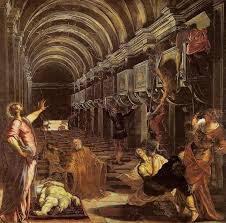
It is interesting to compare the contrast in mannerist and renaissance styles with Tintoretto's ‘Last Supper’ and Leonardo Da Vinci’s.
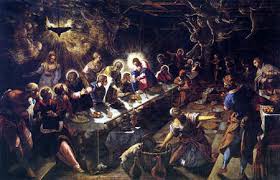
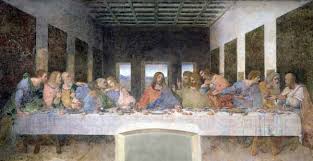
The most extraordinary mannerist painter was El Greco (1541-1614) painting in Spain. He was one of those that painted limbs that were not quite in proportion with the rest of the body as was popular for a while. More striking for the time though is that the finish of his later paintings is not smooth and clearly defined. This is something Tintoretto had done but to a much lesser extent. People were not used to this and found El Greco’s work confusing. Much of his work looks more like it was painted in the late 19th or 20th Century than the late 16th Century.
We are creeping into the next century here but have a look at El Greco’s ‘View of Toledo’ from 1599-1600 below and you see how modern his art looks. By the time he paints ‘the opening of the Fifth Seal we are in to the 17th Century so there will be a little more of him to come.
In Architecture
Architects continued in the renaissance style (that is using the classical form of ancient Rome and Greece like columns, triumphal arches and perfect symmetry) begun by Brunelleschi and it had spread its way across the whole of Europe by the end of this century. In Rome they wanted a church to Rival St Marks in Florence and Donato Bramante 1444-1514 began St Peter’s papal Basilica in 1506 which came to be probably the largest christian church ever built and holds 60,000 people. It had the widest dome in the world until the 19th century. With this building Bramante was let loose to design on the grandest scales without being restricted by the practicalities of an ordinary building. The whole building would have been even grander but the church ran out of money to complete Bramante’s original design. They began to finance it by selling pardons to sinners. This then sparked the reformation and eventually had to stop meaning there was less money to continue. After Bramante’s death Michelangelo contributed most towards the end product of St Peters and it is considered one of his greatest architectural achievements.
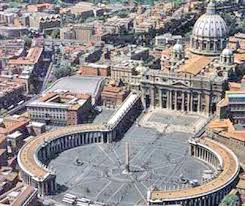
The most influential architect not only of this century but in Western history was Andrea Palladio (1508-1580) who designed many villas, palaces and churches in Northern Italy from the 1530s through to the 1580s. He was able to transfer the renaissance style from the stately urban and religious buildings to the homes of the wealthy and is best known for his villas like the villa Rotunda. This communicated the importance and status of the wealthy home owner and the style was copied thousands of times over across Europe for centuries to come. One reason why he was so influential was because he wrote ‘The 4 books of architecture’ in which he explained his methods. His style was picked up by the French as a number of chateaus sprung up in the Loire Valley and later in England too by architects like Inigo Jones and Christopher Wren.
In philosophy
Martin Luther wrote his ninety-five theses (95 things wrong with the church) published in 1517 and nailed it to the church door at Wittenerg in reaction to the idea that the church could sell pardons to sinners. This started the age of reformation of the church in Europe. Also a key figure in this movement was the humanist thinker Desidius Erasmus. He had published his most well known work ‘In Praise of Folly’ in 1509 in which he satirises the institutions of the church. His view was that man’s worship of God should be based on his own reasoning rather than dictated by the doctrines of the church. Erasmus though believed in reforming the catholic church from within rather than breaking away with the protestants like Luther.
Thomas More, wrote his ‘Utopia’ in 1519 in which he described an idealistic society not unlike communism. Although a friend of Erasmus, More defended the catholic church for Henry VIII who was allying with the Holy Roman Emperor and Roman Catholic church at the time and attacked the ideas of Luther in the early 1520s. Later when Henry wanted to break from the church he had Thomas More beheaded as More did not agree.
The church knew it had to clean up its act and began the counter-reformation in 1534, the year Henry VIII broke away. As part of this it set up the Council of Trent in 1545 which convened regularly for about 20 years and the catholic church succeeded in regaining popularity. So now you had Europe split more than ever before between catholics and protestants and this led to more conflict.
Niccolo Machiavelli wrote ‘the Prince’ which was published in 1532 which takes the view that the ends justify the means. The basic jist is that as long as your end goal is for the good you can be as bad as you need to, to achieve it. This is a little scary but very influential and may be rubbed off a bit on Henry VIII and some of the other leaders in this century.
Nicoloaus Copernicus 1473-1543 kept quiet about his idea that the earth went round the sun (instead of the other way round as was commonly believed)which he had been formulating for much of his adult life. His friends tried to persuade him but he did not dare publish his De Revolutionibus Orbium Celestium until just before he died in 1543 for fear of the consequences it might have for him. This revolutionary idea completely changed man’s view of himself in the universe and was at odds with the church view that God created the universe for man, with the earth at the centre and the sun, moon and stars revolving around it.
In literature
In England literature really begins to flourish in the final quarter of the decade thanks a bit to support from Elizabeth I with two poets and playwrights in particular making a splash. Firstly Christopher Marlowe main works date from 1587 until he was stabbed and killed in 1593. Marlowe was an influence on William Shakespeare whose plays and sonnets were written and performed from the 1590s going into the next century.
In Technology
Spring power clocks were invented between 1500 and 1510. This meant they clocks could be made smaller and fit on shelves in the home rather than just in church towers. Lead pencils were invented in 1564. In 1593 Galileo invented an early form of thermometer. In 1595 an early type of microscope was invented. in 1596 the flushing toilet was invented.